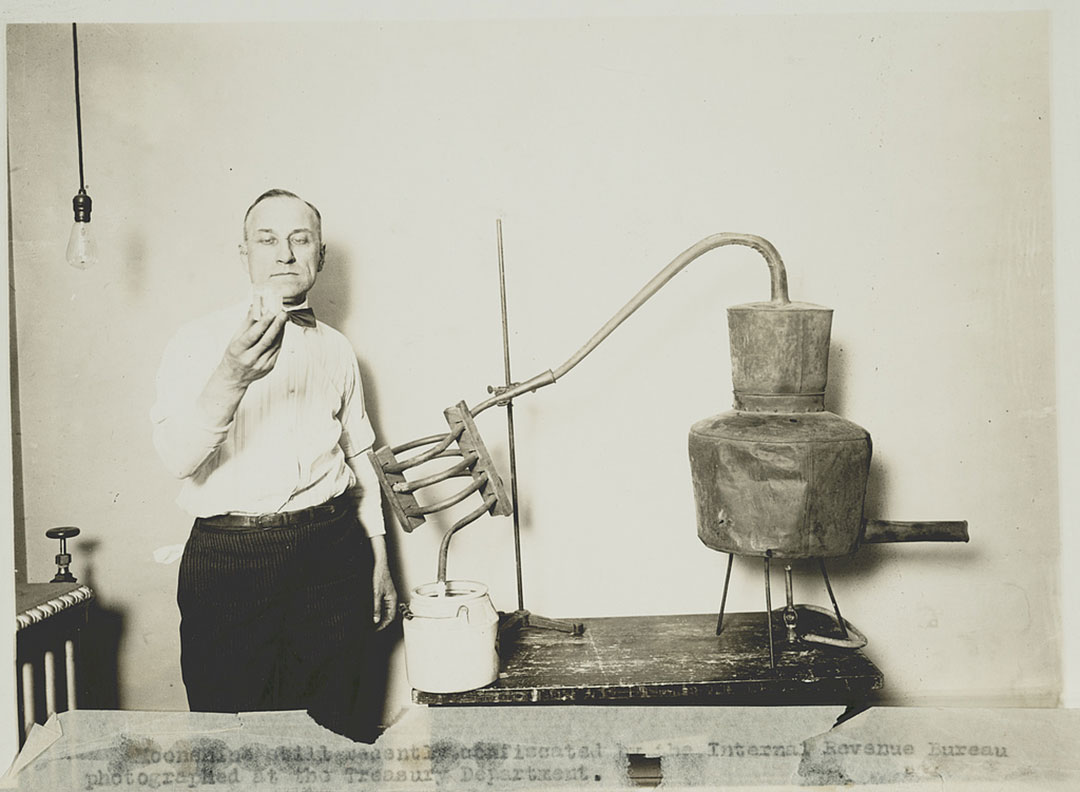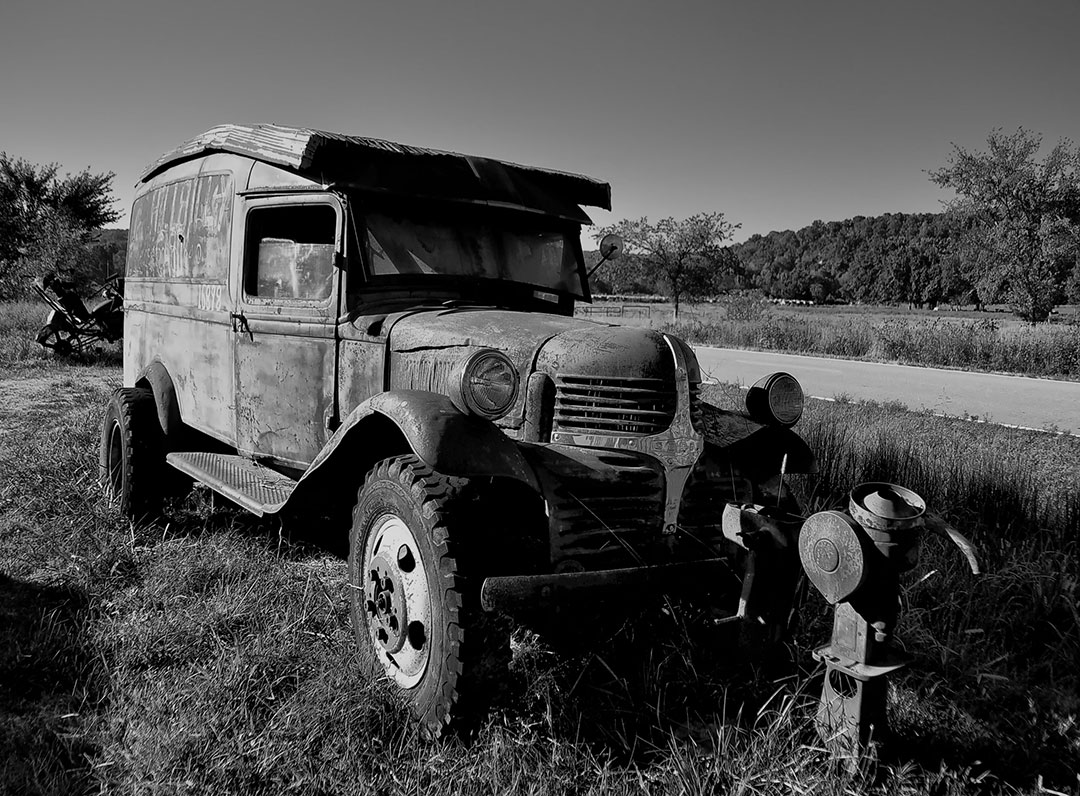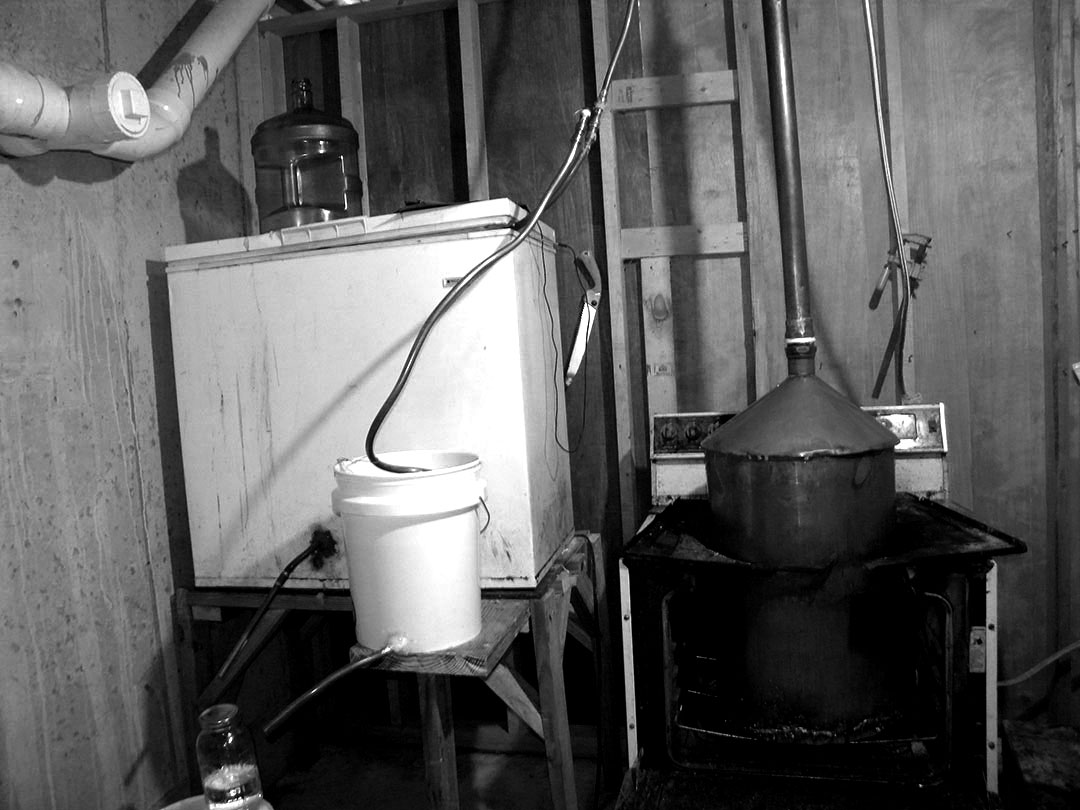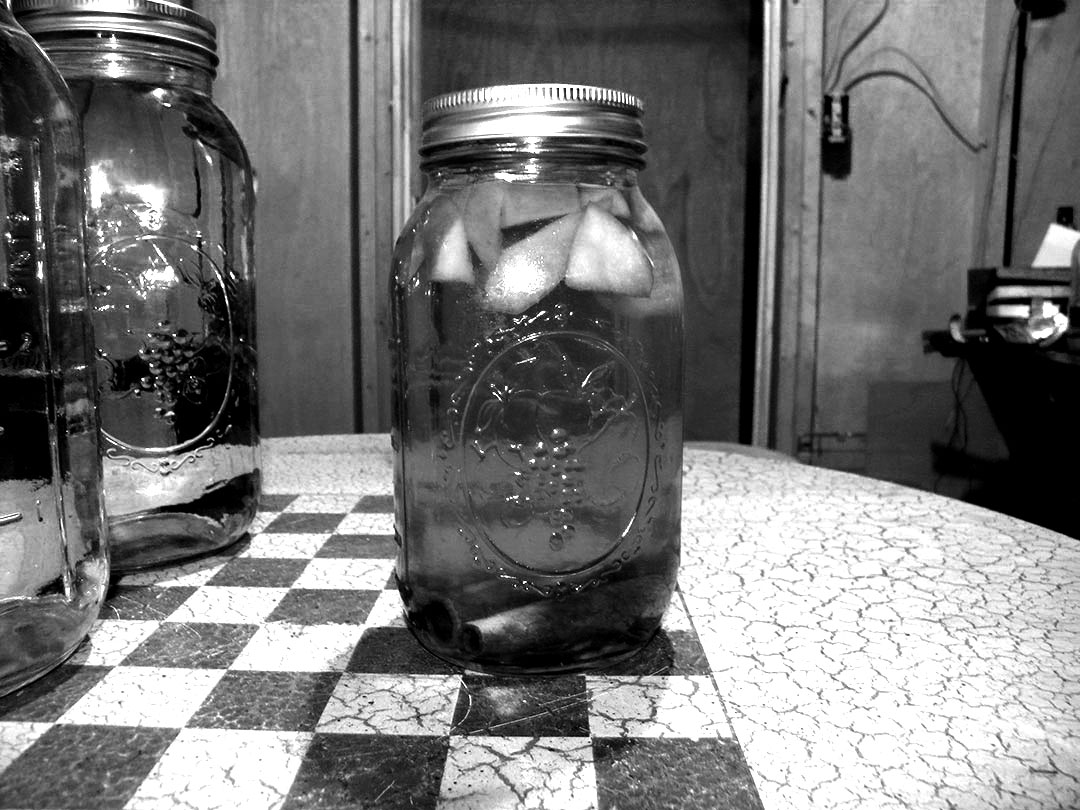
In the hills of the Bluegrass State, a place frontiersman called “the dark and bloody ground,” there is a preference for strong spirits beyond barrel-aged bourbon. Some folks tinker and others perfect a skill of sugar or corn distillation to create hard, super-potent liquor dripped from handmade copper devices that are stored in places where the sun doesn’t shine. Moonshine is the most common term, but it goes by many other names: sugar spirits, mountain dew, rot gut, skat, white mule, stump juice, hooch, white lightning. If it’s good enough and pure enough, it burns true blue.
I’m referring to Kentucky moonshine, of course. I moved to rural Kentucky from suburban Northern Virginia in the Spring of 2013 and fully embraced the Southern tradition by sampling the pride of the Bluegrass: basketball, bourbon, slow-paced life, allergies and moonshine. So enamored with the potency, process and heritage of the hard stuff, I set out to score an interview and sample a jar (maybe two) of the good drink. It didn’t take long to find a guy who knew a guy who, well, so it goes. He calls himself the “Shinologist,” and he invited me into his home-styled distillation abode (on the condition of anonymity, of course) to talk, photograph and learn about an unspoken pride of the Bluegrass.
My first question was a myth buster: Is it true that these homemade moonshine stills can blow up a house? He paused, sighed and said, “If the person who’s making it is fucking retarded.” I knew I was in good hands … or I hoped.
Another question I was set straight on upfront was the start of shining in America: Moonshine did not begin with Prohibition. It existed much earlier — think early as in the earliest American settlers. In fact, alcohol in its various forms is a staple in all cultures, ancient to modern, and home distillation and fermentation was just as common a trade as blacksmithing.
Corn is where moonshine got its start, but the word is now synonymous with nearly any type of illegally home-crafted and distilled liquor — sugar, corn, rye, wood and so on. Early Americans had corn aplenty thanks to trade with Native Americans, and from that crop came good corn liquor. “You can distill anything with starch,” Shinologist told me. “Corn, oak, hickory, sugar, whatever. Yeast, water and your starches, and you can ferment and distill it.”
But let’s back up and see how it all started.

Stills — as in distillation contraptions and the art of home liquor-making — came to America with the early settlers. The Scots, English, Irish, French, Dutch, Germans and Spanish all had a taste for alcohol, and with them they brought stills, expertise and generations of knowledge on how to ferment, brew and distill. One of the most beloved carry-on’s aboard ships sailing to the New World was yeast for the bread and beer and liquor and other eau de vie. The wild spores of America were untested by Europeans, so to be safe they scraped the lees and dregs from the bottoms of homeland vats and transported those strains abroad to be assured of some consistency in their alcohol. People carried on happily brewing and fermenting and distilling until war changed everything.
As a result of the Revolutionary War, the American government was overcome with debt. In an effort to generate revenue, it applied a federal alcohol tax to help manage the financial fray. Home distillers were furious. The Revolutionary War was fought, after all, to free Americans from being subject to British Imperialist taxation, so citizens were furious when the Distilled Spirits Tax of 1791 was created. Most Americans who had distilled continued doing so despite the taxation laws and refused to pay. As a result, the government sent forth tax collectors to obtain their share of the alcohol profits — tax collectors who were greeted with beatings, tarrings and featherings, and who subsequently trod lightly and forced collection halfheartedly. Distillers and farmers, many of whom were one and the same, remained furious, and in July 1794 the Whiskey Rebellion began. A militia force was sent by Alexander Hamilton to eradicate the rebellion, but, in reality, it served to drive distillers deeper underground.
In 1802, Thomas Jefferson repealed the whiskey excise tax and Americans were once again free to legally distill. From 1812 to 1817, the liquor tax was enacted to fund the War of 1812; post war, the tax was repealed. In 1861, burdened with debt from the Civil War, another liquor tax was imposed and has remained ever since. Making liquor (legal or not) was deeply ingrained in the culture of the American South, and for many people, it was the only means by which they had to make a living. The alcohol taxes applied post-Civil War were viewed by Southerners as an extension of Yankee tyranny. As such, local Southern politicians did little to enforce the laws on moonshiners.
Push ahead a few years to an experiment in piety also known as Prohibition. As it turns out, Prohibition was anything but dry — in fact, it’s where ‘shiners really revved up and made a name for themselves, profiting immensely from the low supply of legal alcohol. In the Southern United States, the number of moonshine stills quadrupled and illegal liquor production was at all-time high. To avoid the law, men modified their cars to outrun the police so they could transport moonshine to distribution points. Some of these drivers were the earliest stock car drivers who created NASCAR.

World War II and rationing caused a drop in moonshine due to sugar shortages, but farmers still grew corn crops, and things changed drastically in the 1950s and 1960s, when technological advances improved distillation. During the ‘50s and ‘60s, one out of every five gallons of liquor in America was moonshine. Most large-scale backwoods stills were shut down by 1980, but the practice remained, as recipes and skills were often handed down from generation to generation. Despite arrests and fines, underground distillers persist in producing hot liquor.

But why? What is the magic behind this high-proof, noxious and notoriously illegal spirit that most people have heard of but few understand?
I posed the question to Shinologist. “It’s part of my heritage, being from Appalachia and all. That type of thing is important to me, knowing where you come from and keeping traditions alive,” he said. “I really got interested in the process through the Foxfire books, and things evolved from there.” Foxfire, he explained, are a set of guides designed to teach the survival and daily living techniques from old Appalachia. “Things like tanning hides, distilling liquor, growing herbs — the kind of skills important to the heritage of this place.”
And why call it moonshine? He laughed. “Well, the sun don’t shine on a moonshine still. Seriously, though, back in the day, ‘shiner’s did their thing by moonlight. Things have changed a little over time, but it still ain’t the sort of thing you’d do in broad daylight out in the open.”

I looked around Shinologist’s distillation zone: quart Mason jars in stacks, some empty, many full, filled with crystal clear liquid. Copper, freezer, cooker, two 50-gallon mash barrels and enough sugar to survive a zombie apocalypse. I could get behind the whole heritage part of it, but why go rogue and brew illegal hooch when you can get a buzz from the liquor store store?
“Because I love moonshine, it’s part of the history of this area, and I think that’s important. At least it’s important where I come from. If not for ‘shine there wouldn’t be an America. This whole region to Maine to Tennessee is survived by bootleggin’ liquor. It’s in the American heritage, and that’s important. I remember back when I was younger, before I got into it, a person would say, ‘I gotta jar of ‘shine,’ and people were like fuckin’ buzzards swooping in trying to drink it.”
Shinologist was right. There was a certain allure about the stuff. “The illegal aspect of everything makes it all the more interesting to people. And, truthfully, that was probably one of the most intriguing parts of it when I started. Simply put, you can’t get it — at least not easily. Nine times out of 10, you get a jar of ‘shine from somebody, it’s gonna taste like piss or burn or make you hungover for three days, but it will not make you go blind, contrary to popular belief. That’s just bullshit. I wanted to make something with the intrigue and with a good taste.”
So, we were back to the age-old mystique of having something hard-to-get. It was the type of curiosity and willingness to push the envelope that founded the New World and offered a hefty state of altered consciousness along the way as a bonus.
I asked him what it meant when someone said “It burns true blue?” I thought, at first, it had something to do with Kentucky, the Bluegrass State and the blue banners of the cultish following that surrounds the University of Kentucky Wildcats basketball team. I was wrong. (Again.)
“It’s about purity and the pour,” he said. “A lot of people think the bluer it [burns], then the more stout and pure, but it’s really about the hotness of the flame and the gases from the alcohol.”
Another of Shinologist’s motivators for distillation came in hopes of finding liquor he could drink in large quantities without getting a hangover. “You see, it’s about hydration, purity and minimizing toxins,” he told me. “The best Scotch, whiskey, vodka, bourbon — they all still have toxins. The higher end, the better, as far as avoiding hangover, but I wanted something so pure and so high proof it would bypass all that. They don’t sell it commercially, so I started to make my own. A hobby turned into a quest for perfection, I guess. Not even the ‘shine you buy in the stores is this high proof.” The idea of avoiding a hangover was noble and practical and, as an avid drinker, held my interest. He pointed to a passel of jars in the corner. “Now, see those over there, they’re not filtered yet and need another run.” I asked about the numbers marked on the lids, and he told me it represented the proof of the liquor. “These two, as you can see, are 165 proof.” Back in the old days, home distillers painted Xs on their moonshine jugs: XX, XXX and so on. The Xs represented the number of times the spirits had been run through the still. Shinologist manages his runs by spacing and magic marker, not exactly the same as an X-marks-the-run, but the general intention remains unchanged.

“I do filtration because of the toxins, particularly the fusel oil that comes off of the alcohol. When I finish the whole process, then I’m left with the most pure spirit I’ve ever drank. Only two things give you a hangover: toxins and dehydration. If you get the toxins outta the way and make sure you fuckin’ hydrate, then you’re gonna wake up and play baseball in the mornin’.”
“The key to makin’ good, smooth liquor is slow and cold,” Shinologist explained.
He walked me to his still, a big conical copper bastard stuffed inside a bored-out stove with a pipe that wormed skyward and was trained toward a deep freezer that looked like it had seen better days.
The first step is to fill up the cooker (the big copper bastard) with “wash.” “'Mash' is the common term, but I use what’s called ‘a wash’ because it’s cleaner and doesn’t have all the particulates inside. I like sugar ‘shine so I mix warm water, add yeast and ferment that until it’s ready.” He showed me some yeast packets and popped a lid on a fermenting wash barrel for a closer look. For those who have tried their hand at homebrewing, the smell of fermentation is a familiar odor across the board: a robust pungency on the tart-y side — and if the concoction is old enough (too old), the eye-watering effect caused by sticking your head into a vat of vinegar. Shinologist’s wash was aromatic and stable, not too old, not too young. It had a twang similar to some of my own attempts at home winemaking.
After the wash is inside the cooker, Shinologist “heats up the stove to 173-degrees until it steams through the column.” He stopped to explain: “What I use here is a nine-tenths refractional column, the same as mainstream distilleries with the exception their columns are 10 feet around with plate systems. Now, when I’m running a batch, I monitor a digital thermometer so I can tell the temp during the whole process. Temperature is key here. That steam reaches the top of the column, and once it gets to the top, you’re as pure as you can get ‘cause copper takes out the formaldehydes, sulfates and sulfites. It’s one of the benefits of copper.”
He pointed to the freezer and told me that it, along with the refractional set up, was one thing that set his operation apart. “The deep freeze is set at -22 degrees. Remember when I said the key is slow and cold? Well, this is where that comes in and why I rigged this up. This here is a 28-gallon still and out of 15 gallons of ferment to 18 percent or so, I can run off four gallons of 150-170 proof flavor.” I asked how he knew the proof, and he pulled out a device that looked like it belonged in a hospital rather than a backwoods moonshine distillery.
“This here is a refractometer,” he said. “The first run in the batch is the hottest, and it gradually cools down. I use a refractometer to tell the proof. This one here only goes up to 80 percent and that equals 160 proof. When it’s at 80 percent and you see the peg above that, then it’s safe to say it’s off the scale. I made liquor so hot one day it melted the plastic piece that held my refractometer together and had to get a new one.” He laughs.
The entire thing seemed fairly scientific, and I asked how he acquired it. “I made my whole setup myself. Nothing store bought about it other than the sheet of copper and copper line. The welding, the electrical work, the rerouting is my design, and I don’t know anybody else who has one quite like this. Most of the stills you see are pot stills. This one is a refractional, like I said. I could easily convert it by taking out the copper packing, but then instead of running 180 and 190 proof, I’d be runnin’ 70 and 80 proof. I’d have to run it again to get 140 and 160.You see the dilemma.” I did. “Condensation is one of the key elements. If you don’t get it cool enough when it condenses, then it’s gonna be a harsh and mean liquor and it’s gonna bite and burn. The quicker you get it from steam to liquid, the smoother it will be. Also, the slower you make the steam, the smoother it will be. Slow and cold.” He unscrewed the cooker worm and showed me the cooper packing. It looked like the metal pot scrubbers you buy in the cleaning aisle at the grocery store.

“The first stuff that drips outta here is the heads — methanol, really. Pitch it ‘cause it’s useless, or use it for cleaning solution. When it comes out, I feel it to test it. It’s real slick, almost greasy, but when it gets to the point where it evaporates immediately, I know the body [the main hooch, the stuff that you actually drink] has started to pick up. It evaporates off your fingers immediately and gets gritty, kind of like when you put isopropyl alcohol on your fingertips and rub. That’s the feel you’re looking for to let you know you’ve reached the body. There’s also difference in the smell during the changeover from heads to body to tails.
“The side worm on the distillation setup controls for the tails. The tails are the end part of the run, and there’s a dilemma with the deep freeze temperature and the liquor proof. The tails start runnin’ at 70 to 80 proof liquor. My problem is once you get into the deep freeze at -22, 70 or 80 proof will freeze solid and clog up my line. One-hundred proof won’t freeze at -22, and I can run through the water and catch all the way down to what’s called low wine. Low wine is drinkable, but once the run has gone to that point there’s no body left in the brew and it’s best to toss it. Simplification is everything, and this is as simple as you can get. I can walk around upstairs doing other stuff and have a monitor on my side to tell me the temperature and I know what’s going on the whole time it’s runnin’.”
“You’re somewhat of a connoisseur, so I need you to taste this and tell me what you think,” Shinologist said and pushed a jar of ‘shine toward me that floated apple bits and cinnamon sticks. “Trust me. Go ahead and take you a good sip there.”

“Holy shit that’s good” was all I could think to say. It was smooth: not too hot and not too bland. It was like the porridge Goldilocks ate. “I call it Apple Pie,” he said. “It’s one of my signature ‘shines. That and pineapple and chocolate cherry.” I was intrigued by the cherry and asked him to explain. “Maraschino cherries and chocolate — it has to be dark chocolate though for the right flavor. I put that combo inside a jar of ‘shine for a week or so and let it sit. The chocolate doesn’t melt and when you taste it, it’s like biting into a chocolate covered cherry. Everybody loves it.”
Shinologist recently purchased an oak barrel from a Kentucky bourbon distillery and plans to age a batch of ‘shine and test the results. “I’ve used corn for ‘shine mash, but I don’t care for it much. I’ve made it from apple bases, and hell, I even went to the store and bought box wine and run it to test for the best mix. The straight sugar is still my favorite.”
Whether for the sake of heritage, intrigue or hobby, I’m now fully convinced that the backwoods moonshine-making I previously viewed as archaic and dangerous is not only making a comeback, but taking a profoundly technical slant with refractometers, digital thermometers and folks with the skills and ingenuity to weld, wire, design and experiment with flavorful fermentation recipes.
Shinologist believes that with the advent of the Internet more people will start experimenting with making ‘shine and that he looks forward to seeing where the art will go. He absolutely wants to teach the craft to his own children and hopes that ‘shining, like beer-brewing and home winemaking, will one day be legal. His dream job is working at one of the Kentucky distilleries, but, in his own words, “I can’t exactly advertise my skills to the public. How am I gonna put all this on a resume without going to jail?”
K. M. McCann calls Kentucky home and is part Irish, part Scottish and claims some 16th century, haphazardly documented Huguenot lineage. In other words: She enjoys copious amounts of alcohol. She also writes occasionally for various publications and has a novel forthcoming. McCann works as an adjunct professor/writer and enjoys drinking and reading and porch-sitting, often at the same time.
This longform article about moonshining is brought to you by Come Here Often?, an anthology of 53 writers raising a glass to their favorite bars.
A neighborhood bar can become a second home or a memory best forgotten. But what makes a particular bar special, better than the one down the street? The answers vary considerably as writers share personal stories of drinking establishments around the world, from a remote island on the equator to the frigid windswept landscape of Antarctica.
This funny, smart and poignant collection edited by Sean Manning with a foreword by Malachy McCourt includes essays by Joe Meno, Alissa Nutting, Davy Rothbart, Rosie Schaap, Andrew W. K. and more. Purchase your copy today.